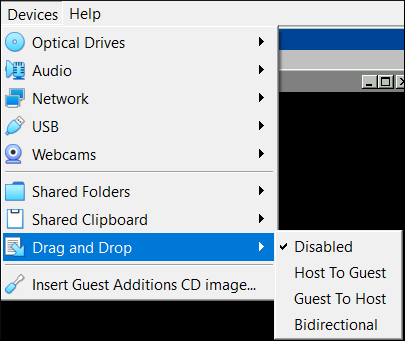VirtualBox is an open-source hypervisor software package that enables virtual guest operating systems to be hosted on Windows, macOS or Linux computers. The software was developed by Sun Microsystems and is now maintained by Oracle. Guest operating systems can achieve network access through the host machine. The availability of resources such as memory and storage may limit the number of concurrent virtual guests that the physical computer can host.

How to share a printer in VirtualBox
5: Use video memory wisely If you're working with a Desktop VM, you don't need to give that VM more than 128MB of vRAM. Conversely, do not waste your vRAM on a GUI-less server, as they will. Dec 19, 2019 Follow these steps to enable VirtualBox to use a USB printer. Install the free VirtualBox Extension Pack to make use of the greater speed available with USB 3.0. After installation, launch the guest operating system in the virtual machine. Use a USB port on the physical host to connect the VirtualBox printer.

USB passthrough is supported in VirtualBox 5.0. This allows printing from a VirtualBox session. Follow these steps to enable VirtualBox to use a USB printer.
- Install the free VirtualBox Extension Pack to make use of the greater speed available with USB 3.0.
- After installation, launch the guest operating system in the virtual machine.
- Use a USB port on the physical host to connect the VirtualBox printer.
- Go to Devices -> USB and select the printer. Click on ‘USB device to share’ to make the printer available to the virtual session.
- After the USB connection has been established, VirtualBox printer sharing is enabled. The virtual machine will recognize the USB device and allow you to use it as if it were directly connected to your session. You now have the ability to print remotely from your VirtualBox guest operating system.
Note: You are limited by the fact that only one VirtualBox session at a time can use the USB printer.
VirtualBox Printer Passthrough
Many virtualization solutions do not provide the support required to enable local USB devices to be accessed. There may be situations where the USB connections are not being recognized and you cannot print from VirtualBox.
There is a software solution that addresses the lack of USB device support in your virtual sessions. USB Network Gate lets your VirtualBox sessions share a printer attached to the host computer. It provides a simple method of connecting to any type of USB device from guest virtual machines.
Here’s how to set up a network printer in VirtualBox in just a few simple steps:

Find more information from our video tutorial:
Why implementing VirtualBox printer passthrough using USB Network Gate is an easy method of sharing USB devices

- USB Network Gate enables virtual sessions to access USB devices over a network by using redirection technology. Traffic transmitted through USB ports is redirected to an IP-based network such as your LAN or the Internet. It makes it easy to connect to any network-attached USB device from within VirtualBox sessions. The extended functionality of the software enables sharing a USB device connected to any networked computer, not just the local host machine.
- USB Network Gate is a cross-platform solution that enables you to access USB devices in virtual machines running on Windows, Linux or macOS hosts.
Install Mac Os On Virtualbox
Related Articles
Virtualbox For Mac Review
- 1 First Steps
- 1.4 Supported Host Operating Systems
- 1.8 Running Your Virtual Machine
- 1.10 Snapshots
- 1.14 Importing and Exporting Virtual Machines
- 1.15 Integrating with Oracle Cloud Infrastructure
- 1.18 Soft Keyboard
- 2 Installation Details
- 2.1 Installing on Windows Hosts
- 2.2 Installing on Mac OS X Hosts
- 2.3 Installing on Linux Hosts
- 2.4 Installing on Oracle Solaris Hosts
- 3 Configuring Virtual Machines
- 3.1 Supported Guest Operating Systems
- 3.2 Unattended Guest Installation
- 3.4 General Settings
- 3.5 System Settings
- 3.6 Display Settings
- 3.11 USB Support
- 3.14 Alternative Firmware (EFI)
- 4 Guest Additions
- 4.2 Installing and Maintaining Guest Additions
- 4.3 Shared Folders
- 4.4 Drag and Drop
- 4.5 Hardware-Accelerated Graphics
- 4.7 Guest Properties
- 4.8 Guest Control File Manager
- 4.10 Memory Overcommitment
- 4.11 Controlling Virtual Monitor Topology
- 5 Virtual Storage
- 5.11 vboximg-mount: A Utility for FUSE Mounting a Virtual Disk Image
- 6 Virtual Networking
- 6.3 Network Address Translation (NAT)
- 7 VBoxManage
- 7.8 VBoxManage modifyvm
- 7.10 VBoxManage import
- 7.11 VBoxManage export
- 7.37 VBoxManage unattended
- 7.38 VBoxManage snapshot
- 7.39 VBoxManage clonevm
- 7.40 VBoxManage sharedfolder
- 7.41 VBoxManage extpack
- 7.42 VBoxManage dhcpserver
- 7.43 VBoxManage debugvm
- 7.44 VBoxManage cloudprofile
- 7.45 VBoxManage cloud
- 7.46 VBoxManage signova
- 7.47 VBoxManage updatecheck
- 7.48 vboximg-mount
